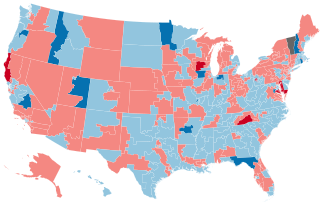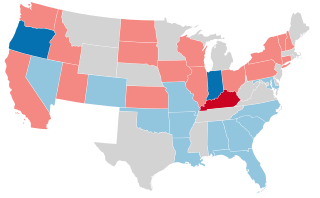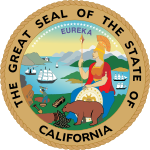
Amasa Leland Stanford was an American attorney, industrialist, philanthropist, and Republican Party politician from California. He served as the 8th governor of California from 1862 to 1863 and represented the state in the United States Senate from 1885 until his death in 1893. He and his wife Jane founded Stanford University, named after their late son.
The 100 seats in the United States Senate are divided into three classes for the purpose of determining which seats will be up for election in any two-year cycle, with only one class being up for election at a time. With senators being elected to fixed terms of six years, the classes allow about a third of the seats to be up for election in any presidential or midterm election year instead of having all 100 be up for election at the same time every six years. The seats are also divided in such a way that any given state's two senators are in different classes so that each seat's term ends in different years. Class 1 and class 2 consist of 33 seats each, while class 3 consists of 34 seats. Elections for class 1 seats are scheduled to take place in 2024, class 2 in 2026, and the elections for class 3 seats in 2028.

David Bennett Hill was an American politician from New York who was the 29th governor of New York from 1885 to 1891 and represented New York in the United States Senate from 1892 to 1897.

James Thompson Farley was a United States Senator from California.

Stephen Mallory White was an American attorney and politician from California. A Democrat, he was most notable for his service as a U.S. Senator from 1893 to 1899.

The 1990 United States House of Representatives elections was an election for the United States House of Representatives on November 6, 1990, to elect members to serve in the 102nd United States Congress. They occurred in the middle of President George H. W. Bush's term. As in most midterm elections, the president's Republican Party lost seats to the Democratic Party, slightly increasing the Democratic majority in the chamber. It was a rare instance, however, in which both major parties lost votes to third parties such as the Libertarian Party as well as independent candidates.
The California Republican Party (CAGOP) is the affiliate of the United States Republican Party in the U.S. state of California. The party is based in Sacramento and is led by chair Jessica Millan Patterson, the first Latina to lead the party.

The 1908–09 United States Senate elections were held on various dates in various states. As these U.S. Senate elections were prior to the ratification of the Seventeenth Amendment in 1913, senators were primarily chosen by state legislatures. Senators were elected over a wide range of time throughout 1906 and 1907, and a seat may have been filled months late or remained vacant due to legislative deadlock. However, some states had already begun direct elections during this time. Oregon pioneered direct election and experimented with different measures over several years until it succeeded in 1907. Soon after, Nebraska followed suit and laid the foundation for other states to adopt measures reflecting the people's will. By 1912, as many as 29 states elected senators either as nominees of their party's primary or in conjunction with a general election.

The 1894–95 United States Senate elections were held on various dates in various states. As these U.S. Senate elections were prior to the ratification of the Seventeenth Amendment in 1913, senators were chosen by state legislatures. Senators were elected over a wide range of time throughout 1894 and 1895, and a seat may have been filled months late or remained vacant due to legislative deadlock. In these elections, terms were up for the senators in Class 2.

The 1869 United States Senate election in New York was held on January 19, 1869, by the New York State Legislature. Incumbent Senator Edwin D. Morgan stood for a second term in office, but lost the support of the Republican legislative caucus in favor of Reuben Fenton.
The 1885 United States Senate election in New York was held on January 20, 1885, by the New York State Legislature to elect a U.S. Senator to represent the State of New York in the United States Senate.
The 1891 United States Senate election in New York was held on January 20 and 21, 1891, by the New York State Legislature to elect a U.S. Senator, to represent the State of New York in the United States Senate.

The 1897 United States Senate election in New York was held on January 19, 1897, by the New York State Legislature to elect a U.S. Senator to represent the State of New York in the United States Senate.

The 1896–97 United States Senate elections were held on various dates in various states. As these U.S. Senate elections were prior to the ratification of the Seventeenth Amendment in 1913, senators were chosen by state legislatures. Senators were elected over a wide range of time throughout 1896 and 1897, and a seat may have been filled months late or remained vacant due to legislative deadlock. In these elections, terms were up for the senators in Class 3.

The 1872–73 United States Senate elections were held on various dates in various states, coinciding with President Ulysses S. Grant's re-election. As these U.S. Senate elections were prior to the ratification of the Seventeenth Amendment in 1913, senators were chosen by state legislatures. Senators were elected over a wide range of time throughout 1872 and 1873, and a seat may have been filled months late or remained vacant due to legislative deadlock. In these elections, terms were up for the senators in Class 3.

The 1890–91 United States Senate elections were held on various dates in various states. As these U.S. Senate elections were prior to the ratification of the Seventeenth Amendment in 1913, senators were chosen by state legislatures. Senators were elected over a wide range of time throughout 1890 and 1891, and a seat may have been filled months late or remained vacant due to legislative deadlock. In these elections, terms were up for the senators in Class 3.

The 1988 United States Senate election in California took place on November 8, 1988. Incumbent Senator Pete Wilson won re-election to a second term.

The 1895 United States Senate special election in California was held on January 23, 1895, by the California State Legislature to elect a U.S. Senator to represent the State of California in the United States Senate. Incumbent Republican Senator George Clement Perkins, who was appointed by Governor Henry Markham to fill the vacancy caused by the death of Senator Leland Stanford in 1893, was re-elected to a full term in office, defeating newspaper publisher and fellow Republican M. H. de Young, Democratic former Lieutenant Governor John Daggett, and several other minor challengers.















